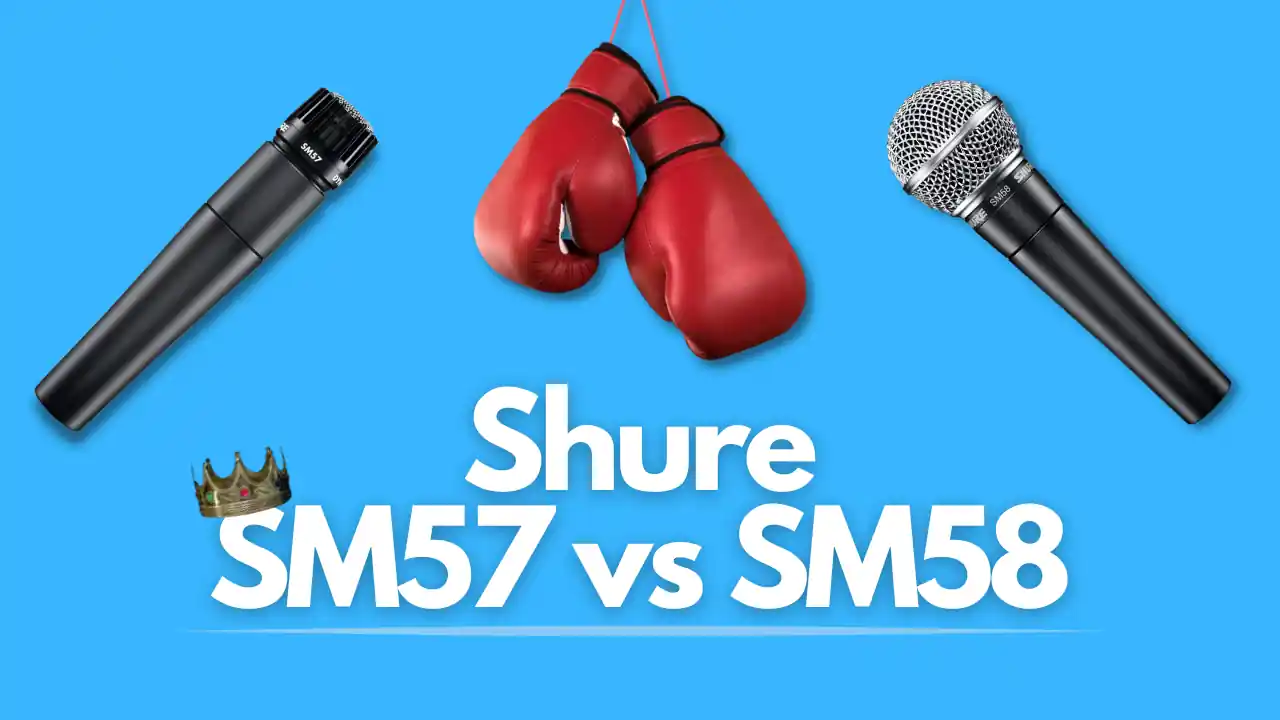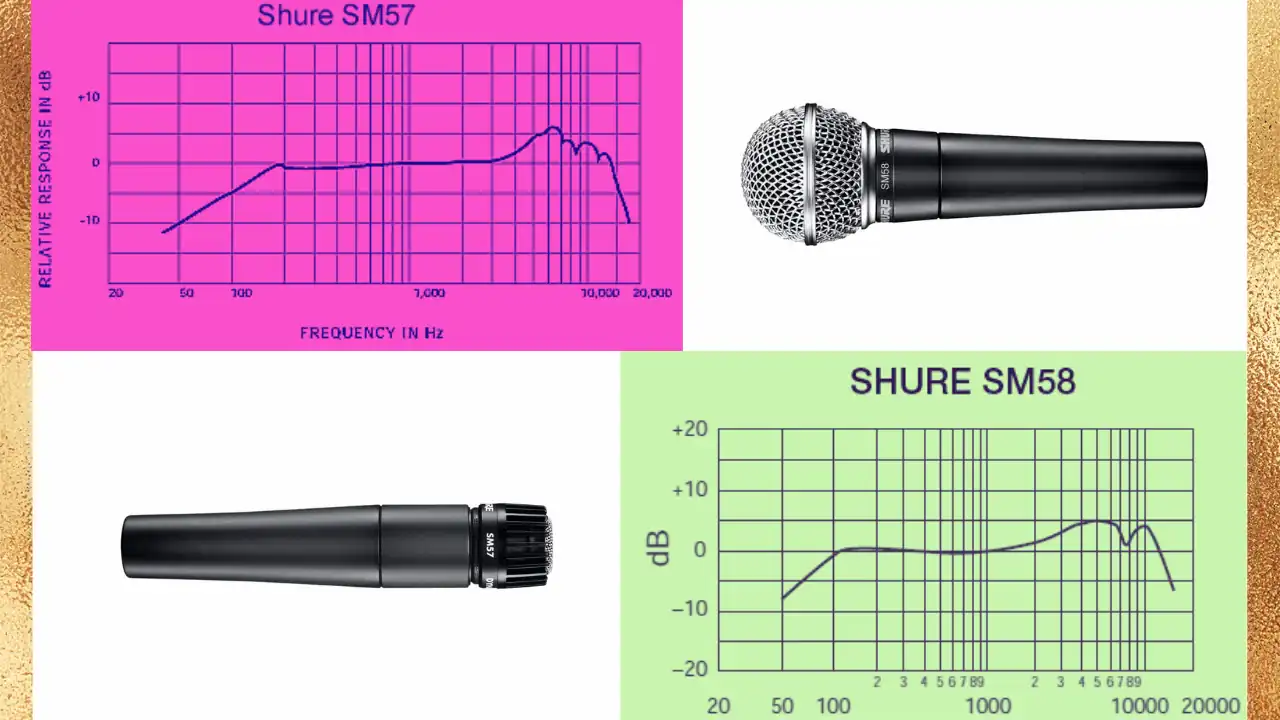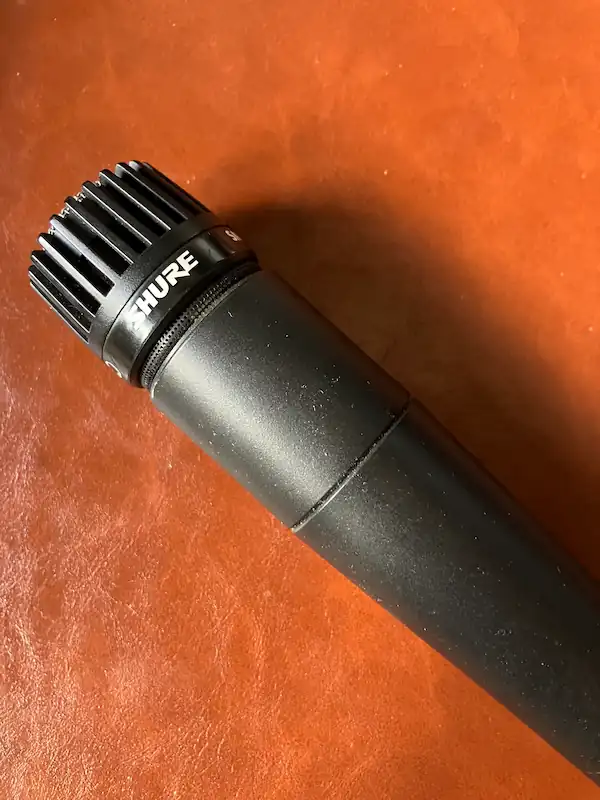Shure SM57 vs SM58

I get it. We all want to sound great without breaking the bank. A good microphone is essential to capturing a great sound. And the Shure SM57 and SM58 are both great mics for around $100.
Considering that these are two of most the popular microphones of all time, it can be difficult to choose the right one for your needs.
Both the SM57 and SM58 are durable dynamic microphones that have become industry standards, but which one is right for you? In this review post, I’ll provide a detailed comparison of the Shure SM57 vs SM58 to help you make an informed decision.
First, I’ll explore the similarities between these two Shure microphones, highlighting their shared build quality and dynamic capsule design. I’ll also discuss the many applications where both the SM57 and SM58 can shine, such as mic’ing up guitar amps, snare drums, and vocal performances.
Finally, I’ll take a closer look at the subtle differences between the two, including their different frequency response ranges and polar patterns to help you pick the best mic for your needs.
Note: this article may contain affiliate links, which mean that I receive a commission for any purchases you make, at no added cost to you.
Basic Features of Each Microphone
When it comes to microphones, there are a few basic features to consider that affect their sound quality and performance. The Shure SM57 and SM58 are both dynamic microphones that share many similarities in terms of performance. Visually, they share a lot in common, with the key difference being the grille design.
Both microphones are great for home recording as well as live performances. Indeed, these are often "go to" live microphones due to their durability and affordability. On top of that, you can plug these dynamic mics right into your audio interface or mixer without needing to use phantom power!
Both the SM57 and SM58 require an XLR cable to connect them to a sound source. Both are relatively heavy, smallish microphones that expect to be aimed directly at the sound source. Unlike a condenser microphone, the fact that they don't pick up much noise "bleed" from other sound sources is another reason they excel in chaos of live shows.
Neither mic features a on off switch. Nor does either mic include any other high-pass filters or pad features. They are simple, great-sounding work horses trusted by sound engineers so much that they have become industry standard and concerts and studios.
I can still remember 20 years ago when the singer in my band upgraded from a cheap Radioshack mic to an SM57. It was like night and day - I could finally understand the lyrics to our songs!
Frequency Response of the Shure SM 58 vs SM 57
If you're deciding on which microphone to buy for your home recording or live performances, it's important to understand the differences between the SM57 and the SM58. One key difference is their frequency response.

The SM57 has a flatter frequency response to the upper-mids, at which point it features a nearly 5-dB boost in the upper mids, which makes it versatile for a variety of instruments such as drums, guitar amps, and horns. It is also one of the best mics for acoustic guitar live. Above 10kHz, however, its frequency response starts to drop off rapidly. Surprisingly, the SM57 still sounds great in the studio and is still a top mic for recording snare drum.
On the other hand, the SM58 emphasizes mid-range frequencies, making it a popular choice for vocals. This emphasis on mid-range frequencies starts around 1kHz to bring out the warmth and clarity of the singer's voice, making it easier to cut through the mix in a live setting. Like the SM 57, the SM58's frequency response starts to drop off rapidly above 10kHz.
While both mics sound great live I wouldn't recommend either when it comes to recording in a studio due to the fact that they fail to record all those "airy" high frequencies. Instead, I'd recommend one of these vocal mics for studio use.
Understanding these differences in frequency response can help you make a more informed decision when choosing between the SM57 and SM58 for your specific recording or performance needs.
What is the SM58 Best For Capturing?
For vocals, the Shure SM58 is the better choice due to its cardioid polar pattern which helps reduce background noise and feedback. The main visual difference of this mic is its ball grille, which is designed with a built-in pop filter to reduce plosive sounds, making it ideal for vocal performances on stage. The SM58 has a frequency range of 50Hz to 15kHz, which provides a warm and smooth sound for singing.
The Shure SM58 is a versatile dynamic microphone mainly used for vocals, both live performances and home recordings. Due to its excellent sound quality, durability and versatility, the SM58 is widely considered the best microphone for live vocals, especially on stage. It has a cardioid polar pattern, which means it captures sound from the front while rejecting sound from behind. This makes it ideal for live performances as it reduces feedback and rejects unwanted sounds.
Of the two, the SM58 is better for home recording of vocals because its tailored frequency response which enhances vocals and reduces ambient noise. However, compared to other options for a home studio (for example, the Shure SM7B), SM58 lacks a little something when it comes to capturing clear and crisp vocals.
What is the SM57 Best For Capturing?
The Shure SM57 dynamic microphone is known for its versatile applications in music recording and live sound. Unlike the SM 58, the main difference visually is that the top of the grille of the SM 57 is flat, and does not incorporate a pop filter or wind screen. Of course, these are really cheap to buy separately if you need them.
It is a popular choice for home recording studios that want to capture clear and natural-sounding instruments. The microphone has a consistent cardioid polar pattern that helps isolate sound in noisy environments while reducing feedback.
One of the key features of the SM57 is its ability to handle high sound pressure levels, making it suitable for use with guitar amps and drum kits.
On the other hand, the Shure SM57 has a flat frequency response that makes it more versatile for recording instruments such as guitar amps, drums and brass instruments. This microphone can handle high sound pressure levels with its dynamic element and is built to perform well in harsh stage environments. Its tight unidirectional polar pattern helps to focus on the sound source, giving a natural sound to the recording.
Just put it in front of some cranked guitar cabs and it will capture the roar perfectly.
Of course, the SM57 isn't just an instrument mic.
When it comes to vocals, the SM57 is a decent option, but it lacks the smoothness of the SM58. While the SM57 can handle vocal duties, the SM58 is widely preferred due to its ability to emphasis on mid-range frequencies that enhances the human voice. In other words, the Shure SM57 dynamic microphone is best suited for recording instruments in home recording studios and for live performances due to its durability and versatility in handling high sound pressure levels.
Conclusion: Both microphones are durable and reliable, and have been used by professionals for decades.
In conclusion, it's safe to say that both the Shure SM57 and SM58 microphones are durable and reliable, and have been used by professionals in various industries for decades. While they have slight differences in their frequency response and pickup pattern, both mics are excellent choices for home recording, vocals, and live performances.
The SM57, with its more neutral sound, is ideal for recording instruments and is often used for recording electric guitar, drums, and other instruments. On the other hand, the SM58's emphasis on mid-range frequencies makes it a popular choice for vocals, both in the studio and on stage. Ultimately, the decision between the two microphones depends on your specific needs and preferences. However, with either the SM57 or SM58, you can be confident in its exceptional quality and performance.
In conclusion, both the Shure SM57 and SM58 microphones are excellent choices for various purposes, and both have their unique features that cater to different styles and needs of users.
Whether you are a vocalist or instrumentalist, you can rely on the Shure SM57 for an accurate and uncolored representation of your sound, while the SM58 works well for live performances and vocal applications with its enhanced sensitivity and frequency response. Ultimately, the choice between the two will depend on your specific requirements, but you can rest assured that both of these microphones are built to deliver top-notch sound quality and superior performance.
From a Frustrated Producer in a Ragtag Bedroom Studio to Major Placements on TV Earning $1,000s!
My name is Evan, and I've been making music since around 3rd grade. I'm from San Diego, California, but I've lived in Washington, DC for the last 20 years.
While I still have a full-time day job, I have created systems that have allowed me to produce dozens of songs a year in my spare time.
My songs have been on Netflix, TV shows like the 90 Day Fiance, an award-winning indie film, and NPR’s “All Thing Considered.” They've also been streamed millions of times.
In addition to being a music producer, I am passionate about teaching people how they can make professional-sounding music and earn money licensing it, all in their spare time.
Thousands of musicians, like yourself, have trusted me to guide their musical journey. My YouTube videos have been watched nearly a million times. And my story has been in Forbes, Side Hustle Nation, and the Side Hustle School.









